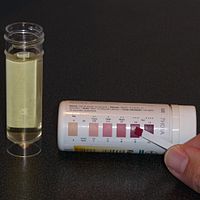
Photo from wikipedia
The ketogenic diet (KD) is a widely used therapeutic option for individuals with medically refractory epilepsy. As the diet's name implies, ketosis is a historically important component of the diet,… Click to show full abstract
The ketogenic diet (KD) is a widely used therapeutic option for individuals with medically refractory epilepsy. As the diet's name implies, ketosis is a historically important component of the diet, but it is not well understood how important ketosis is for seizure control. The ketogenic ratio is defined as the ratio of fat to carbohydrate plus protein by weight in the diet (grams). Traditionally, the classic KD contains a 4:1 ratio, and a very high proportion of fat in the diet. The classic KD, with its high proportion of fat and limited carbohydrate intake can be restrictive for patients with epilepsy. Recently, there is experience with use of lower ketogenic ratios and less‐restrictive diets such as the modified Atkins diet and the low glycemic index treatment. In this narrative review, we examine the role of ketosis and ketogenic ratios in determining the efficacy of the KD in children with epilepsy.
Journal Title: Epilepsia
Year Published: 2022
Link to full text (if available)
Share on Social Media: Sign Up to like & get
recommendations!